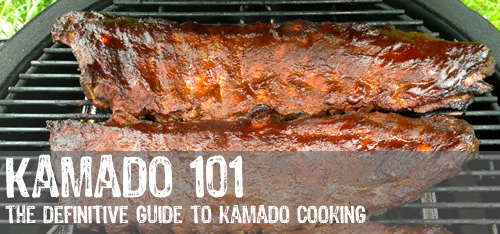
Note: This post is part of the “Kamado 101 – The Definitive Guide to Amazing Barbecue” series, in which I cover everything from the foundational aspects of Kamado cooking all the way through advanced concepts designed to transform you into a backyard barbecue pitmaster. View the entire series here.
Welcome to the very first article in the Kamado 101 series! If you’ve never heard of Kamado style cookers before or if you’ve just picked up a Big Green Egg or Kamado Joe and have no clue how to get started with it, you’ve found the right page.
Today’s topic is simply defining what a Kamado is and how it works. So with that said, let’s dive right in.
A Kamado is a Japanese term for a circular clay or ceramic cooking vessel which uses wood and / or charcoal to cook food. Incredibly, the use of Kamados date back over 3,000 years and there’s actually a pretty interesting story about how they eventually proliferated in other parts of the world which you can read about here.
Modern Day Kamados
Modern Kamado grill brands you might be familiar with include The Big Green Egg, Kamado Joe, Primo Ceramic Grills, and Grill Dome. These grills use a combination of high temperature ceramics, terracotta, and crushed lava rock to create a grill that can withstand temperatures in excess of 750F without cracking from extreme heat or temperature fluctuations.
The primary advantage of a Kamado style grill is the fact that they’re so incredibly versatile. Try to find another type of grill that not only allows you to grill, but also to smoke low and slow (my personal favorite), bake, high-temp sear (just like famous steak houses), and even cook wood-fired pizza in much the same way your local pizzeria does. Between all these different cooking methods available at your fingertips, you have a near countless number of ways to prepare various types of food.
In addition, modern Kamados are fueled by lump charcoal which has been proven to burn hotter and for longer periods of time making it ideal for smoking large cuts of meat at low temperatures. Lump charcoal also produces much less ash than standard charcoal briquettes allowing for greater air flow and thus producing a longer-lasting heat source. Because of this and their uncanny ability to preserve heat, Kamados can run for as long as 12 hours, completely unattended!
Kamado Parts
Now, let’s take a look at the various components that comprise the modern day Kamado:
While there are slight variations among all Kamados, the vast majority of them resemble the diagram above, in large part.
So, starting at the top of the diagram, you’ll notice the following parts:
Top vent: This vent allows you to fine tune the cooking temperature within the Kamado using a daisywheel type device. You’d be surprised as to just how accurate you can dial in your temperatures using the top vent and I’m going to explain exactly how to do so in a future post.

The top vent on my Kamado Joe
Stainless steel grate: The surface used to hold food while it cooks. While Most Kamados come with stainless steel grates, there are a plethora of options out there for customizing the cooking surface to accommodate just about anything you’d ever want to cook. You can add extender racks, swing racks, cast iron grates, griddles, and more. It’s easy to get carried away with grate customizations, but I recommend using the grate that came with your Kamado for at least as long as it takes you to get a feel for cooking well on it consistently.
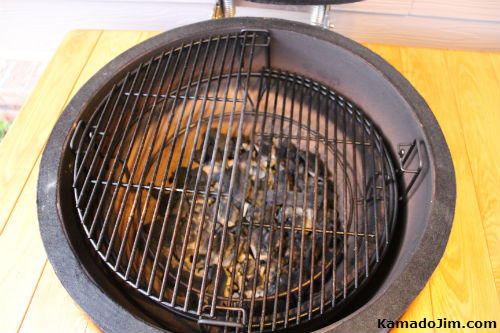
The stainless steel grates in my Kamado Joe
Dome: Otherwise known as the lid to the Kamado. You’ll notice that the bottom of the dome is typically lined in a felt material that helps to create a near air-tight seal when closed which greatly aides in heat retention and prevents unnecessary moisture from escaping the cooker.
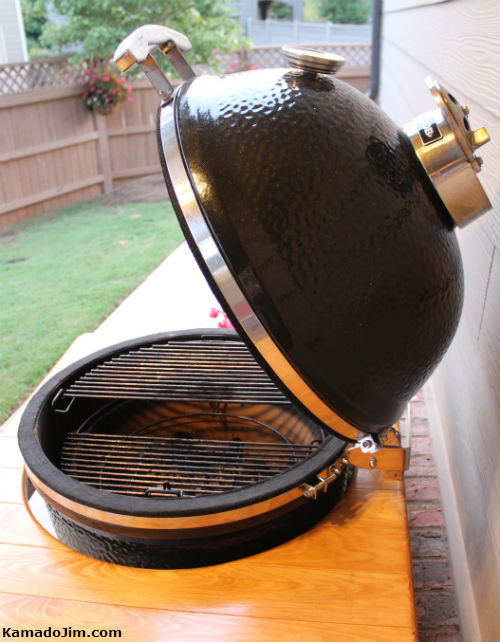
The fully opened dome on my Kamado Joe
Thermometer: Used to tell the current temperature in the dome. While the dome temperature is good to know, more important is the cooking surface temperature which can be off from the dome thermometer by more than 50 degrees. There are a number of devices which can accomplish this for you and I list a few that I recommend over on the Tools I Use page. For a full selection of thermometers and other accessories, check out the Kamado Jim shop.
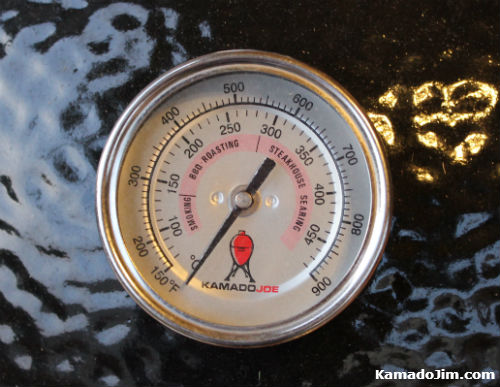
The dome thermometer on my Kamado Joe
Hinge: The hinge is what connects the Kamado dome to the base and is oftentimes the most overlooked part of the Kamado. The hinge is the only thing standing between the Kamado dome and the ground beneath it, so it’s absolutely vital that it be tightened regularly to ensure you don’t come outside to find a shattered dome one day.
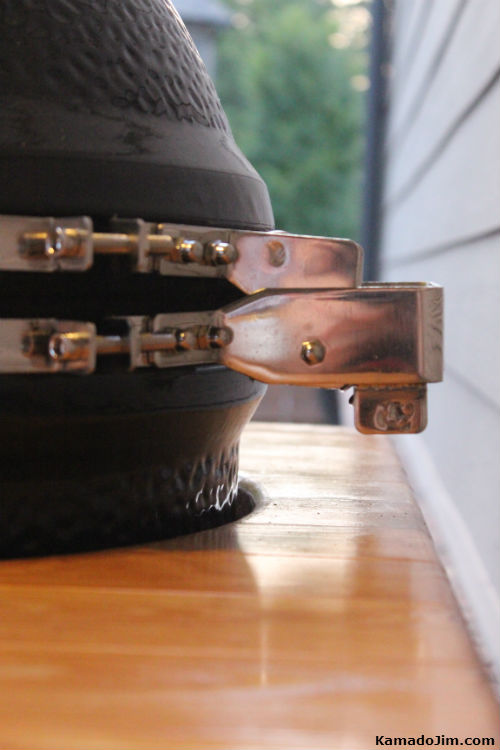
The hinge on my Kamado Joe
Fire ring: The fire ring is a piece of ceramic that site directly above the fire box and creates the space between the charcoal and the cooking grate. You’ll typically fill your fire box up with charcoal to the bottom of the fire ring.
Fire grate: The fire grate is the slotted piece that you set your charcoal and wood on. It sits on the bottom of the fire box. The slots or holes in the fire grate allow small pieces of wood, charcoal, and ash to fall through to be disposed of later.
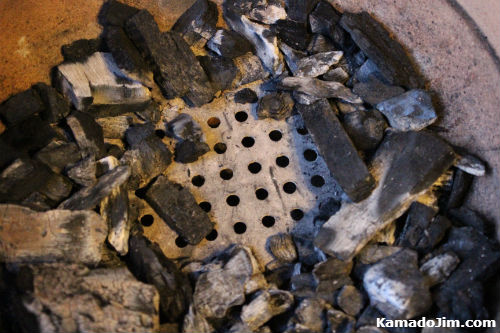
The fire grate in my Kamado Joe
Fire box: The fire box is where you pour your charcoal and place your wood. The bottom of the fire box contains the fire grate. The fire box typically has a few holes drilled into the sides of it to allow for air flow which provides the oxygen needed to maintain a fire.
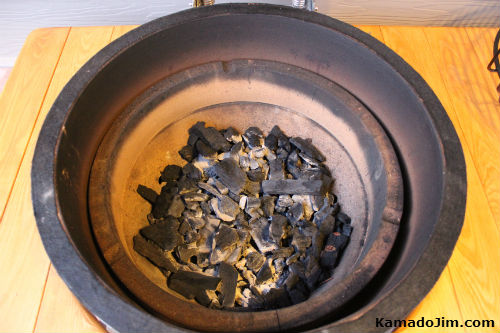
The fire ring and fire box in my Kamado Joe
Bottom vent: The bottom vent is your primary air source and where the Kamado will draw the oxygen required to maintain a fire. When grilling, I typically keep the bottom vent open 100% to increase the air intake which leads to hotter temperatures. When smoking on the other hand, when I’m close to achieving my desired temperature, I’ll shut the bottom vent down so that only about a half inch or so is open. Adjusting your bottom vent to achieve a desired temperature takes a bit of practice and will be covered in depth in a future post.
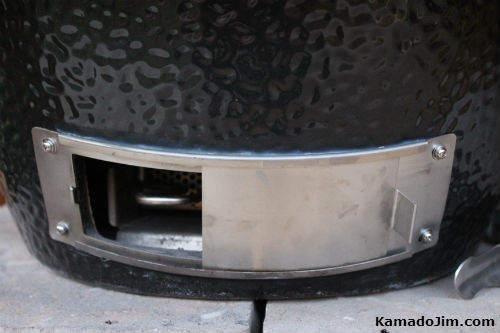
The bottom vent on my Kamado Joe
Wrapping Up
And there you have the ins and outs of the components which comprise Kamado cookers as well as a few of the advantages they hold over gas and charcoal grills.
Make sure to regularly check the Kamado 101 page as I continue this series of posts designed to take you from Kamado newbie to neighborhood pitmaster in just a few short articles!
Lastly, as always, if you still have questions about your Kamado grill or if you’d like me to discuss something a little more in-depth, feel free to leave a comment below and I’ll do my best to help!
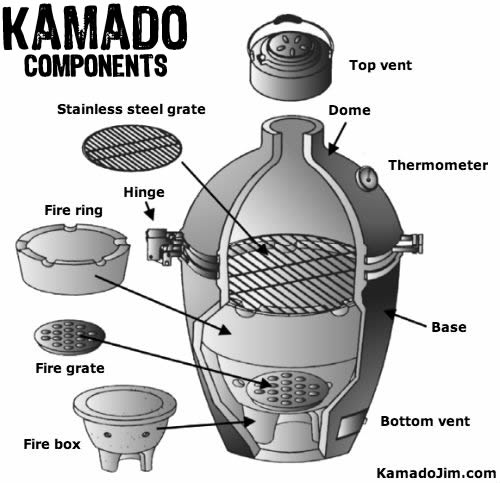
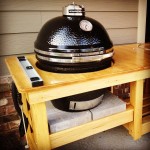
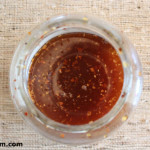
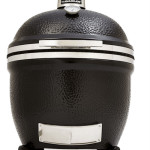
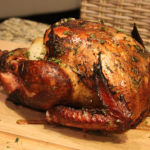

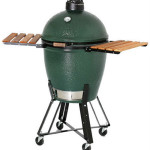
Hi! I was wondering if the table yr grill sits in, is custom built or available to buy? Thanks
Hi there, Julie. I actually found that table advertised on my local craigslist site. There was a gentleman who made and sold them out of his garage. The table was unfinished when I purchased it, so I added a few coats of stain and polyurethane to it to help make it look a little nicer and hold up to the elements.
18 months later and it’s still working out great. It does show the occasional burn mark and grease spot though. I’ll probably sand it down this spring and apply a few more coats of polyurethane to freshen it up a bit.